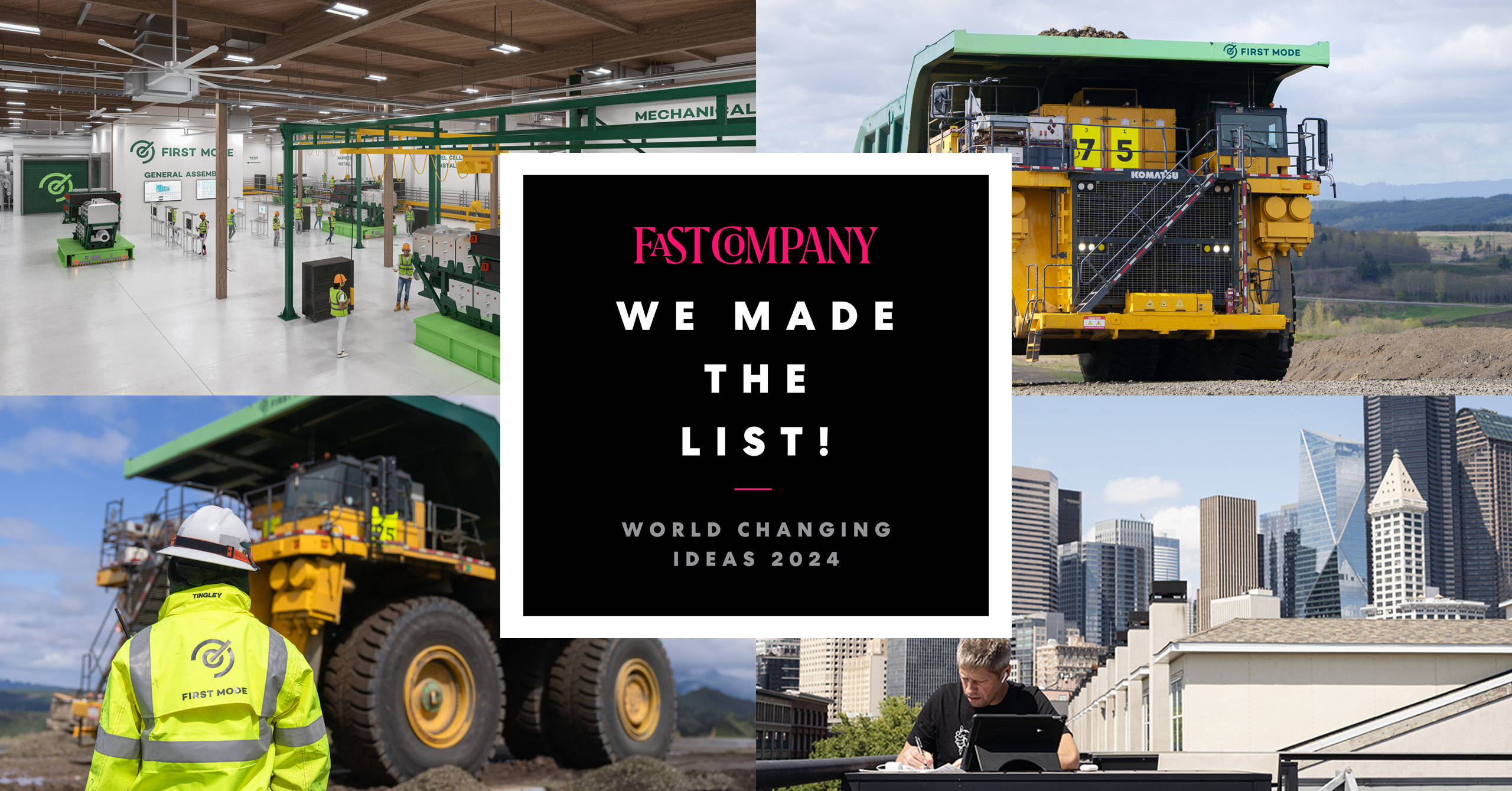The May 6 launch of Anglo American’s nuGen hydrogen haul truck, powered by a fuel cell and battery powerplant designed and built by First Mode, is a superlative engineering achievement. This project has created the world’s largest zero-emission truck, and the powerplant represents a zero-emission upgrade that serves as a pathfinder for a commercially viable upgrade kit. Such a decarbonization product could be applied to the next generation of retrofitted mining trucks, as well as vehicles in other heavy industries such as rail and maritime.
Related story: The Road to Powering the World’s Largest Zero-Emission Vehicle
“Even though much of the zero-emission technology used in the nuGen truck existed commercially, it did not exist as a cohesive commercial element suited to the scale and ruggedness of this kind of truck,” said Josh Sweere, a principal systems engineer at First Mode. “The team had to take these commercial systems and scale them to meet the power demand of an ultra-class haul truck. Stitching together commercial components that were never meant to coexist simultaneously on the same platform required a lot of ‘glue’ engineering to allow the system’s various fluids, communications connections, and power connections to peacefully coexist.”
What Does the Powerplant Do, and How Was It Designed?
In addition to providing electrical power to the wheels via the vehicle’s drive electronics, the two-megawatt powerplant supports the vehicle’s auxiliary systems, including hydraulics and steering, all without compromise and with direct feed-forward potential. One of the challenges in developing the powerplant was that the building blocks of a zero-emission truck are fundamentally larger than the building blocks of a diesel truck.
Power generation, batteries, hydrogen storage, and the power electronics that connect First Mode’s powerplant to the nuGen truck’s drivetrain all take up significant space, far more than the diesel systems that were removed to accommodate them. At first the team focused on trying to mimic diesel operations with the new zero-emission system, but this proved difficult in a vehicle that was designed expressly for an internal combustion engine.
“Operating in an over-constrained environment meant that we needed to optimize around the fundamental ways that the truck creates value,” explained Spencer Anunsen, also a principal systems engineer at First Mode. “Thermal constraints mean that we can’t simply provide the power rating that the diesel engine had, so optimizing the balance of batteries and fuel cells took on increased importance.”
Once the initial frame of reference was established, the team could illustrate how the limitations of zero-emission technology would unfold within the current operating paradigm, which allowed effective compromises to be made for a proof-of-concept vehicle. After observing the proof of concept in use, the team will gain a greater understanding of the needed direction of the next iteration of a zero-emission haul truck and supporting infrastructure.
The resulting vehicle carries enough hydrogen to enable significant operational testing, and the balance of hybridization—the amount of power provided by the hydrogen fuel cells compared to the amount of power provided by the batteries—makes it possible to store energy from regenerative braking as the truck drives downhill into the mine for each payload, while also enabling significant full-power testing.
These capabilities allow Anglo American and First Mode to validate concepts of operation, which will feed into future generations of commercially-viable zero-emission trucks.
Batteries Versus Fuel Cells: Powerplant Hybridization
Anglo American came to First Mode for the initial study of potential haul truck solutions because First Mode takes a technology-agnostic approach to engineering. Unlike Tesla, for example, which has stated its affinity for batteries over fuel cells, First Mode considered the benefits and drawbacks of both possibilities, as well as a combination of the two, for the task at hand.
The hot, dusty, around-the-clock mining environment presents unique constraints for zero-emission solutions. High availability and utilization requirements mean that the ability to recharge or refuel quickly is more important to the truck’s performance than the high total system efficiency that a battery-only solution could provide.
“Hydrogen has promise but suffers from a past of hype and bust, plus a set of real challenges. Batteries are great, but they have also have limitations,” says Sweere. “Combining these technologies allows our teams to balance the limitations of one with the advantages of the other. Managing the balance of hybridization is key.”
Balancing onboard battery storage with fuel cell power generation allows the truck to take advantage of the best of both worlds, with the batteries enabling energy capture from regenerative braking, and the fuel cells enabling rapid refueling with hydrogen.
Due to variations in temperature, terrain, average workload, and other conditions, the exact same mix of batteries and fuel cells might not make sense at every mine site in the world. However, the team has studied a variety of sites and found that some combination of batteries and fuel cells frequently does provide an optimal solution. The technology underpinning large zero-emission vehicles continues to evolve, so the need to seek the right balance of hybridization for each mining environment is likely to persist well into the next decade.
Key Challenges and Solutions
Many difficulties, both expected and unexpected, had to be overcome to develop the power solution for the nuGen truck over the course of the project’s past three years.
The team knew from the beginning that the generation and management of two megawatts of electrical power on a moving vehicle would be a herculean task, and focused on hiring experienced thermal, hydrogen, mechanical, electrical, software, and systems engineers. On the other hand, an unexpected challenge was the COVID-19 pandemic, which made access to the truck difficult, so that much of the basic design information had to be obtained from co-workers thousands of miles away.
It was also necessary to cope with a lack of clear interfaces for the vehicle. In applying an aftermarket solution to a truck that operates in extreme environments and sees almost constant use, engineers learned that their CAD models rarely reflected the true condition of the vehicles in the Mogalakwena fleet. With the truck expecting a diesel engine and alternator to be present, methods had to be developed to ensure safe operation of the truck while presenting it with an entirely different electrical energy source. (The now fully functional nuGen truck still displays a “diesel empty” warning on its dashboard.) The challenging vibration and shock environment presented by repeated loading with hundreds of tons of ore also required extensive design work for even the simplest components, such as electrical junction boxes, and many preexisting truck systems had to be repaired after removing the original diesel engine.
Building the Barely Possible
One of First Mode’s strengths is the ability to apply a diverse range of skill sets to any problem. The wide variety of engineering experience represented on our team lets any project make use of techniques from many other industries in order to get the job done.
The team relied on experience from the automotive industry to understand the best powerplant-to-drivetrain interface, and leveraged automotive-targeted electrical equipment in its designs. Rail was also a source of technology and inspiration for the high-power aspects of the vehicle. Both automotive and aerospace provided inspiration for the approach to safety used on the project, including the concept of inherently safe design. The team used process engineering techniques from the oil and gas industries in thinking about the storage and transfer of compressed hydrogen. Finally, spacecraft design thinking was applied to ensure that engineers were always thinking about the overall mission, not just the powerplant itself.
In addressing this decarbonization challenge, First Mode engineers have developed an innovative solution that we hope will pave the way for the application of similar solutions in a variety of carbon-intensive industries. While presenting immense decarbonization challenges, these situations also present opportunities for immense impact in the global fight against climate change.
“The service life of assets in these heavy industries is longer than that for consumer goods, so to start near-term adoption, you need to show injection into today’s current systems and current operations,” said Sweere. “Anglo American’s plan to build upon a proof-of-concept vehicle with a pilot fleet and eventual commercial units will allow for the continued demonstration of zero-emission systems in a real-world operating environment. Operations will learn, first-hand, the advantages and disadvantages for zero-emission systems, and with that knowledge I suspect we will see operations begin to change to emphasize the myriad advantages these systems can provide.
“My hope is that other industries will see this in action and understand that to take full advantage of zero-emission systems you must embrace new ways of operating. Operations have had over a century to build around the capabilities and limitations of fossil-fuel-powered equipment, and they’ve learned to extract the most from those systems. The same thing will happen with zero-emission technologies as industries like mining, rail, marine shipping, aviation, and more start to convert to zero-emission and reduced-emission systems—and we need to get that process going now.”
Want to work with us? We’re hiring! First Mode builds the barely possible to enable a sustainable future for everyone, everywhere. Check out our open positions in Seattle and Perth.




